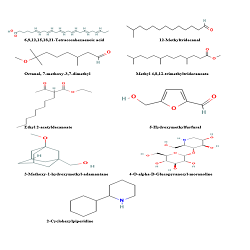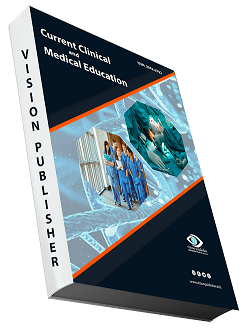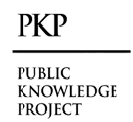Metabolomics by Gas Chromatography-Mass Spectrometry (GCMS): Genotypes, Phenotypes and Secondary Metabolites
Keywords:
Multivariate, Pathway Mapping, Compound, GC-MSAbstract
Metabolomics utilizing gas chromatography-mass spectrometry (GC-MS) is well-suited for the detection and quantification of small molecular metabolites (<650 daltons), such as small acids, alcohols, hydroxyl acids, amino acids, sugars, fatty acids, sterols, catecholamines, drugs, and toxins. Chemical derivatization is frequently employed to render these compounds gas chromatographically volatile. This section demonstrates how GC-MS metabolomics makes it simple to combine untargeted metabolomics for the discovery of new substances with targeted experiments for the absolute quantification of particular metabolites. In human body fluids (e.g., plasma, urine, or stool) samples, GC-MS may detect and semi-quantify over 200 substances each study. This is made possible by database annotations employing huge spectral libraries and established, standardized standard operating procedures. Like liquid chromatography-MS untargeted profiling (LC-MS), deconvolution software allows for the detection of over 300 more unknown signals that can be annotated using precise mass instruments and suitable data processing methods. As a result, gas chromatography–mass spectrometry (GC–MS) is an established technique that employs a variety of mass spectrometers, including traditional quadrupole detectors, target mass spectrometers, and precise mass instruments. Metabolomics using gas chromatography-mass spectrometry is covered in this unit. (i) Collecting data, (ii) checking for quality, and (iv) processing the data obtained from samples of mammals. The creation of secondary metabolites has sparked a lot of attention in the past few years, as has the prospect of improving that production through the use of tissue culture technologies. So far, there has been a good amount of published research and abstracts assessing the antioxidant, antimicrobial, and anti-diabetic properties of numerous plant-derived secondary metabolites. We looked at the bioactivity of eighteen different plant compounds, including flavonoids, alkaloids, and phytosterols. It was discovered that a total of eleven plants exhibited antioxidant, antimicrobial, and anti-diabetic secondary metabolite potential. Many plant parts, including roots, stems, leaves, fruits, and flowers, contain secondary metabolites that demonstrate bioactivity.
Downloads
References
DeJongh DC, Radford T, Hribar JD, Hanessian S, Bieber M, Dawson G, Sweeley CC. Analysis of trimethylsilyl derivatives of carbohydrates by gas chromatography and mass spectrometry. Journal of the American Chemical Society. 1969; 91:1728–1740
Gelpi E, Koenig WA, Gibert J, Oro J. Combined gas chromatography-mass spectrometry of amino acid derivatives. Journal of Chromatographic Science. 1969; 7:604–613
Dixon E, Clubb C, Pittman S, Ammann L, Rasheed Z, Kazmi N, Keshavarzian A, Gillevet P, Rangwala H, Couch RD. Solid-phase microextraction and the human fecal VOC metabolome. PloS one. 2011; 6:e18471. [PubMed: 21494609]
Fiehn O. Metabolomics–the link between genotypes and phenotypes. Plant molecular biology. 2002; 48:155–171. [PubMed: 11860207]
Babushok VI, Linstrom PJ, Reed JJ, Zenkevich IG, Brown RL, Mallard WG, Stein SE. Development of a database of gas chromatographic retention properties of organic compounds. Journal of Chromatography A. 2007; 1157:414–421.
Roessner U, Wagner C, Kopka J, Trethewey RN, Willmitzer L. Simultaneous analysis of metabolites in potato tuber by gas chromatography–mass spectrometry. The Plant Journal. 2000; 23:131–142. [PubMed: 1092
Kleinova M, Belgacem O, Pock K, Rizzi A, Buchacher A, Allmaier G. Characterization of cysteinylation of pharmaceutical-grade human serum albumin by electrospray ionization mass spectrometry and low-energy collision-induced dissociation tandem mass spectrometry. 2005;19(20):2965-73.
Polettini A, Gottardo R, Pascali JP, Tagliaro F. Implementation and performance evaluation of a database of chemical formulas for the screening of pharmaco/toxicologically relevant compounds in biological samples using electrospray ionization-time-of-flight mass spectrometry. Anal Chem. 2008 Apr 15;80(8):3050-7.
Gerlich M, Neumann S.J MetFusion: integration of compound identification strategies. 2013 Mar;48(3):291-8.
Smyth WF.J Chromatogr B Recent studies on the electrospray ionisation mass spectrometric behaviour of selected nitrogen-containing drug molecules and its application to drug analysis using liquid chromatography-electrospray ionisation mass spectrometry. Analyt Technol Biomed Life Sci. 2005 Sep 25;824(1-2):1-20.
Smyth WF, A critical evaluation of high performance liquid chromatography-electrospray ionisation-mass spectrometry and capillary electrophoresis-electrospray-mass spectrometry for the detection and determination of small molecules of significance in clinical and forensic science. Brooks P.Electrophoresis. 2004 Jun;25(10-11):1413-46.
Skogerson K, Wohlgemuth G, Barupal DK, Fiehn O. The volatile compound BinBase mass spectral database. BMC bioinformatics. 2011; 12:321.
Lu, H., Liang, Y., Dunn, W. B., Shen, H., & Kell, D. B. (2008). Comparative evaluation of software for deconvolution of metabolomics data based on GC-TOF-MS. Trends in Analytical Chemistry, 27(3), 215-227.
Halket JM, Przyborowska A, Stein SE, Mallard WG, Down S, Chalmers RA. Deconvolution gas chromatography/mass spectrometry of urinary organic acids–potential for pattern recognition and automated identification of metabolic disorders. Rapid communications in mass spectrometry. 1999; 13:279–284
Ali H: An investigation of antimicrobial compounds for immunomodulating and antiadhesion properties. Immunology and infectious disease and research laboratory, Ph.D. thesis 2003; 01-186. 2.
Chopra and Ananda S. Āyurveda In Selin, Helaine. Medicine across cultures: history and practice of medicine in non-western cultures. Norwell, A: Kluwer Academic Publishers 2003; 75-83.
Gibbons S: An overview of plant extracts as potential therapeutics. Expert Opinion on Therapeutic Patents 2003; 13(4): 489-497.
Dwivedi, Girish, Dwivedi, and Shridhar: ClinicianTeacher par Excellence. Indian J Chest Diseases Allied Sci (Delhi, India: Vallabhbhai Patel Chest Institute, U. of Delhi/National College of Chest Physicians) 2007; 49: 243-44.
Britto SJ and Senthilkumar S: Antibacterial activity of Solanum incanum L. leaf extracts. Asian J Microbiol Biotech Env Sci 2001; 3(1-2): 65-66.
Rao RS and Ravishankar GA: Plant cell cultures: Chemical factories of secondary metabolites. Biotechnol Adv 2002; 20: 101-153.#
Santosh MK, Sharanabasappa GK, Shaila D, Seetharam YN and Sanjeevarao I: Phytochemical studies on Bauhinia racemosa Lam., Bauhinia purpurea Linn. and Hardwickia binate Roxb. E-Journal of Chemistry 2007; 4: 21-31.
Weisshaar B and Jenkines G: Phenylpropanoid biosynthesis and its regulation. Curr Opinion Plant Biol 1998; 1: 251-257.
Okunade AL, Elwin-Lewis MPF and Lewis WH: Phytochemistry 2004; 65: 1017-1032. 10. Mills S and Bone K: Principles and Practice of Phytotherapy–Modern Herbal Medicine. New York: Churchill Livingstone 2000; 31-34.
Ju YH, Clausen LM, Alrd KF, Almada AL and Helferich WG: β-sterol, β-sitosterol glucoside and a mixture of βsitosterol and β-sitosterol glucoside modulate the growth of estrogen-responsive breast cancer cells in vitro and ovariectomized athymic mice. Journal of Nutrition 2004; 134: 1145-1151.
Tiwari R and Rana CS: Plant secondary metabolites: a review. International journal of engineering research and general science 2015; 3(5): 661-670. 13. Vijayvargia P and Vijayvergia R: A Review on Limonia acidissima L.: Multipotential medicinal plant. Int J Pharm Sci Rev Res 2014; 28(1): 191-195.
Vijayvargia P and Vijayvergia R: Assesment of phytochemicals and antioxidant activity of Murraya koenigii Linn. International Journal of Pharmaceutical Sciences and Research 2016; 7(5): 2163-67.
Sharma P, Khandelwal S, Singh T and Vijayvergia R: Phytochemical analysis and antifungal potential of Duranta erecta against some phytopathogenic fungi. International Journal of Pharmaceutical Science and Research 2012; 3(8): 2686-2689.
Sharma P: Isolation and identification of bioactive compounds from some medicinal plants of Verbenaceae. Ph.D. thesis; Department of Botany, University of Rajasthan, Jaipur 2015.
Shah A, Sharma P and Vijayvergia R: Antimicrobial properties of different solvents extract of Rumex vesicarius L. on some selected bacterial and fungal isolates. International Journal of Pharma Sciences and Research 2015; 6(3): 1107-1114.
Shah A: Evaluation of phytochemicals and their antimicrobial properties of Sisymbrium irio Linn. and Rumex vesicarius Linn. Ph.D. thesis, Department of Botany, University of Rajasthan, Jaipur 2015.
Sharma N and Vijayvergia R: A Review on Digera muricata L. Mart. - A Great Versatile Medicinal Plant. Int J Pharm Sci Rev Res 2013; 20(1): 114-119.
Sharma N: Identification and bioefficacy of bioactive from some medicinal plants of family Amaranthaceae. Ph.D. thesis, Department of Botany, University of Rajasthan, Jaipur 2014.
Choudhary S, Tanwer BS and Vijayvergia R: Total phenolic, flavonoids and antioxidant activity of Trichosanthes cucumerina Linn. Drug Invention Today 2012; 4(5): 368-370.
Shah A, Singh T and Vijayvergia R: In-vitro antioxidant properties and total phenolic and flavonoid contents of Rumex vesicuis L. International Journal of Pharmacy and Pharmaceutical Sciences 2015; 7(7) 81-84.
Sharma N and Vijayvergia R: Study of primary metabolites and antimicrobial activities of Gomphrena celosioides Mart. International Journal of Pharma and Bio Sciences 2011; 2(4). IP-5.121
Chaudhary S: Isolation and characterization of bioactive compounds of Melothria maderasptarnia Linn. and Trichosanthes cucumerina Linn. Ph.D. thesis, Department of Botany, University of Rajasthan, Jaipur 2016.
Vijayvergiya P: Studies on some medicinal medicinal plants of Rutaceae as a natural source for bioactive compounds. Ph.D. thesis; Department of Botany, University of Rajasthan, Jaipur 2016.
Alka J, Padma K and Chitra J: Antifungal activity of flavonoids of Sida acuta Burm f. against Candida albicans. International Journal of Drug Development and Research 2016; 4(3): 92-96. #
Jain C, Kumar P and Singh A: Hypoglycemic activity of flavonoids and alkaloids extracted from Aloe vera in two districts of Rajasthan: A comparative study. Elixir International Journal 2013; 62: 17877-17879. #
Chitra J, Padma K, Archana S and Alka J: In-vitro comparisons of anti-diabetic activity of flavonoids and crude extracts of Azadirachta indica A Juss. International Journal of Drug Development and Research 2013; 5(1): 47-54.
Jain C: Comparative study of selected anti-diabetic plants in Jaipur and Bharatpur districts of Rajasthan. Ph.D. thesis; Department of Botany, University of Rajasthan, Jaipur 2015.
Jain C, Singh A, Kumar P and Gautam K: Anti-diabetic potential of flavonoids and other crude extracts of stem bark of Mangifera indica Linn: a comparative study. Journal of Scientific and Innovative Research 2014; 3(1): 21-27.
Gautam K, Kumar P and Jain C: Comparative study of alpha-amylase inhibitory activity of flavonoids of Vitex negundo Linn. and Andrographis paniculata Nees. International Journal of Green Pharmacy 2013; 7(1): 25-2

Downloads
Published
How to Cite
Issue
Section
License

This work is licensed under a Creative Commons Attribution 4.0 International License.
Current Clinical and Medical Education













